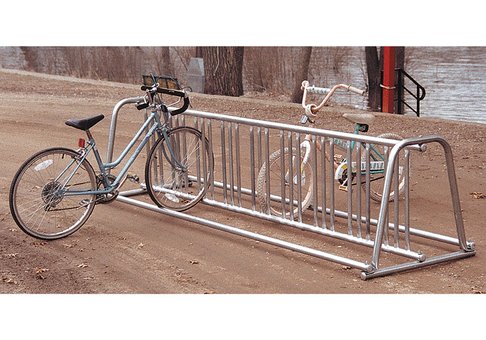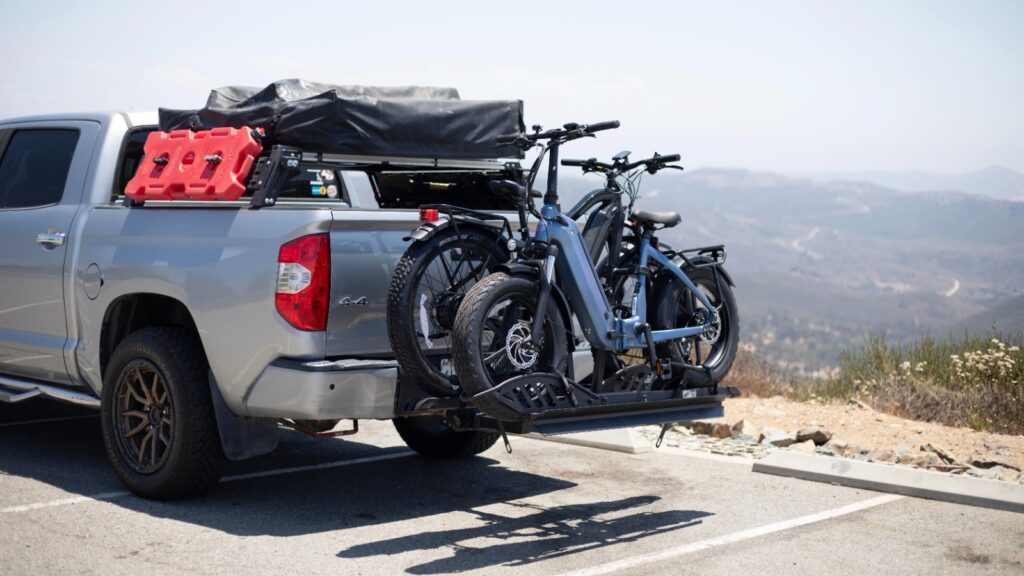Analyzing Different E Bike Rack Options for Larger Vehicles
Wiki Article
Explore the Different Sorts Of Bike Shelf and Their Practical Applications for Biking Enthusiasts
The variety of bike Racks available today deals with the varied demands of biking enthusiasts. From freestanding to wall-mounted choices, each layout uses distinct benefits for storage space and transport. Portable Racks additionally supply adaptability for those on the relocation. Selecting the excellent type calls for cautious consideration of details requirements. Comprehending these factors can make a considerable difference in both comfort and safety for bikers. What are the key considerations when selecting a bike rack?Comprehending Bike Shelf Types
Numerous kinds of bike Racks deal with the varied requirements of bicyclists. Amongst one of the most usual are freestanding shelfs, typically found in urban areas, which permit multiple bikes to be secured in a compact room. Wall-mounted Racks serve those with limited floor area, offering an effective service for home storage. Furthermore, mobile bike racks, developed for simplicity of transportation, allure to bicyclists that regularly travel.
Hitch-Mounted Bike Racks
Hitch-mounted bike Racks supply a useful option for transferring bikes, yet comprehending their setup process is crucial for efficient usage. Users must additionally think about the weight capability of these Racks to guarantee security and stability while traveling. In addition, compatibility with various lorry types plays a considerable role in determining the best shelf for private needs.Setup Refine Overview
When choosing a hitch-mounted bike rack, understanding the setup process is vital for assuring security and benefit. Initially, the user should verify compatibility in between the car and the shelf's hitch receiver. Many Racks are made for either 2-inch or 1.25-inch receivers. After picking the appropriate rack, the installment starts with securing the rack into the hitch receiver and tightening up the drawback pin or screw to protect against movement. Correct placement is crucial to establish the shelf does not block tail lights or license plates. When mounted, it is suggested to look for stability by using small pressure to the rack. Adhering to the producer's guidelines will certainly assure an effective installment, promoting a risk-free biking experience on the road.Weight Capacity Considerations

Compatibility With Vehicle Types
Picking the best bike shelf entails verifying compatibility with various lorry kinds. Hitch-mounted bike Racks are designed to connect to the rear hitch receiver of an automobile, making them suitable for a wide variety of trucks, autos, and suvs. It is crucial to inspect the drawback course and weight capability to verify an appropriate fit. Many hitch-mounted Racks work with 1.25-inch and 2-inch receivers, accommodating lorries equipped with suitable hauling capacities. In addition, individuals need to consider their lorry's height and layout, as some Racks may obstruct back access or need extra clearance. Ultimately, comprehending automobile specs confirms that cycling fanatics can securely carry their bikes without compromising security or capability.Trunk-Mounted Bike Racks
Trunk-mounted bike Racks supply a useful service for bikers looking for an efficient means to transport their bikes. Comprehending the setup procedure is vital for suitable use, as incorrect setup can bring about security problems. Additionally, thinking about the weight ability of these Racks warranties that they can firmly hold the bikes without threat of damage or failing throughout transportation.Setup Process Introduction
Lots of cycling enthusiasts appreciate the comfort of trunk-mounted bike Racks for their simplicity of use and flexibility. The setup procedure usually starts with unloading the shelf and familiarizing oneself with its elements. A lot of Racks come with adjustable straps and hooks made to secure them to the vehicle's trunk or hatch. Customers should validate the rack is positioned properly, straightening it with the lorry's contours for security. Adhering to the maker's guidelines, the straps are then tightened firmly, guaranteeing a snug fit. It is very important to check that the rack does not obstruct the automobile's lights or permit plate. Verifying that all links are safe before packing bikes is essential for safe transport. Correct setup improves both safety and effectiveness during cycling trips.Weight Capability Considerations
When considering a bike shelf for delivering bicycles, weight capacity is a crucial variable that can not be forgotten. Trunk-mounted bike Racks generally carry weight restrictions that differ depending upon the model and layout. It is crucial for users to inspect these specs to guarantee they do not go beyond the advised weight, as doing so can jeopardize both security and vehicle integrity. Many trunk-mounted Racks can support one or 2 bikes, with a consolidated weight capacity varying from 70 to 120 pounds. Cyclists should likewise think about the weight of their bikes, especially if they possess heavier designs like electrical bikes. Appropriately matching the rack's weight capability with the bikes' weights assures a safe and secure and safe transport experience.Roof-Mounted Bike Racks
Roof-mounted bike Racks provide a structured option for transporting bikes, supplying bicyclists with the advantage of optimizing freight space. These Racks are developed to hold bikes firmly atop the lorry, enabling easy access to the rear of the automobile and preventing obstructions to the license plate or tail lights. They are excellent for people who frequently take a trip with their bikes, as they can suit different bicycle styles and dimensions.Installment normally involves affixing the rack to the automobile's bars, guaranteeing a secure and risk-free fit. Roof-mounted Racks are frequently aerodynamic and light-weight, which can lead to enhanced gas effectiveness compared to various other kinds of shelfs. Users must consider the elevation of their lorry when packing and dumping bikes, as well as possible challenges when entering garages or low-clearance locations - Bike Rack. Overall, roof-mounted bike Racks supply a versatile and efficient option for devoted bikers on the go
Wall-Mounted Bike Racks
Wall-mounted bike Racks offer a reliable option for cyclists seeking to make best use of limited room while securely keeping their bikes. These Racks are excellent for urban occupants or those with tiny garages, as they boost bikes off the ground and make use of vertical room. Made from durable products, wall-mounted options can suit different bike kinds, including mountain, crossbreed, and roadway bicycles.Installation is simple, enabling users to mount them in garages, basements, and even outdoor rooms. Numerous designs enable for one or numerous bikes, making them flexible for private or family usage. Furthermore, some wall-mounted Racks come with incorporated locks or safety attributes to deter theft, improving peace of mind for cyclists.
Portable Bike Racks
Portable bike Racks use bikers a hassle-free and flexible service for transporting their bicycles. These Racks are designed for easy installation and removal, making them ideal for those who need to regularly change between places or automobiles. Portable and normally light-weight, portable bike Racks can be quickly stored in a trunk or garage, relieving the worry of permanent setups.There are various types of mobile bike racks, including hitch-mounted, trunk-mounted, and roof-mounted alternatives, each satisfying various car kinds and biker choices. Hitch-mounted Racks give stability and accessibility, while trunk-mounted Racks are usually a lot more versatile and economical. Roof-mounted Racks are excellent for optimizing freight room yet may call for some training.
Picking the Right Bike Rack for Your Requirements
Just how can one figure out the very best bike shelf to match their specific cycling needs? Determining the appropriate bike rack includes examining a number of elements. Initially, one should consider the kind of car made use of for transport, as Racks are made for different placing systems, such as roofing, trunk, or hitch. Next, the number of bikes to be carried is vital; some Racks accommodate just one, while others can hold several bikes efficiently. In addition, identifying the weight and framework design of the bikes is substantial, as certain Racks are better suited for much heavier or distinctly shaped bikes. Desired use must be taken into account; regular travelers might choose an extra portable alternative, while periodic users may prioritize simplicity and ease of installation. By thoroughly evaluating these considerations, individuals can select a bike shelf that fulfills their demands and enhances their cycling experience.
Frequently Asked Concerns
Can Bike Racks Accommodate Different Bike Sizes and Styles?
Bike Racks vary in layout, making it possible for holiday accommodation for different bike sizes and styles. Some Racks feature adjustable parts, while others are specifically customized for sure bikes, making certain safe storage space and easy accessibility no matter of the bike's specifications.Just how Do I Appropriately Safeguard My Bike on a Rack?
To effectively secure a bike on a rack, one should guarantee the structure and wheels are snugly fastened utilizing locks or straps, looking for stability and protecting against movement during transport to prevent damages.Are Bike Racks Easy to Set Up and Get Rid Of?
Bike Racks vary in installment complexity, however many are created for user-friendliness. Removable designs commonly offer uncomplicated arrangement and elimination, while long-term setups may require tools and even more time, depending on the certain design.
What Materials Are Bike Racks Usually Made From?
Bike Racks are normally made from products such as steel, plastic, and light weight aluminum. Hitch Bike Rack. Steel gives durability and strength, while aluminum uses light-weight portability. Plastic choices are frequently created for simplicity of use and affordabilityDo Bike Racks Affect Gas Performance When Driving?
The question of whether bike Racks influence fuel performance when Bike Rack driving is substantial. Research studies suggest that bike Racks can raise aerodynamic drag, possibly bring about reduced fuel efficiency, particularly at greater rates or with added weight.After picking the ideal shelf, the installment begins with protecting the shelf right into the drawback receiver and tightening the drawback pin or bolt to avoid motion. Roof-mounted Racks are frequently aerodynamic and light-weight, which can lead to improved gas performance compared to other kinds of shelfs. Hitch-mounted Racks provide stability and ease of access, while trunk-mounted Racks are typically extra flexible and economical. Next off, the number of bikes to be carried is necessary; some Racks suit only one, while others can hold multiple bikes effectively. Bike Racks vary in style, enabling lodging for different bike dimensions and styles.
Report this wiki page